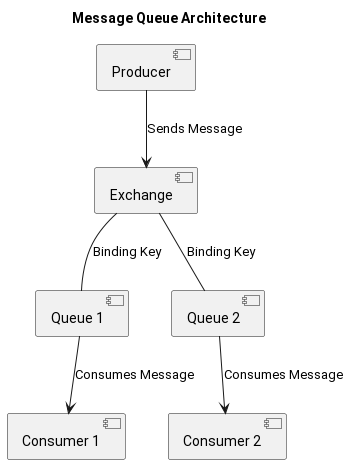Advanced Message Queuing Protocol
Table of Contents
1. Systems Breakdown
1.1. 1. Key Components of the AMQP System:
- Producers (Publishers): Applications that create and send messages.
- Exchanges: Routing agents that receive messages from producers and distribute them to queues based on rules (bindings).
- Queues: Storage units that hold messages until they are consumed by consumers.
- Consumers (Subscribers): Applications that receive and process messages from queues.
- Bindings: Rules that define the relationship between an exchange and a queue, determining which messages the exchange should route to the queue.
- AMQP Server (Message Broker): The central component that hosts exchanges and queues, and manages message routing.
- Channels: Virtual connections within a TCP connection that allow for multiple concurrent operations.
- Connection: A TCP connection between the client and the AMQP broker.
1.2. 2. Analysis of Relationships and Interactions:
- Message Flow:
- A producer sends a message to an exchange.
- The exchange uses bindings to determine which queue(s) should receive the message.
- The exchange routes a copy of the message to each matching queue.
- Consumers subscribe to queues and receive messages.
- Exchange Types: Different exchange types (Direct, Fanout, Topic, Headers) dictate how messages are routed.
- /Direct:* Routes messages to queues with a binding key that exactly matches the routing key of the message.
- /Fanout:* Routes messages to all queues bound to it.
- /Topic:* Routes messages to queues whose binding key matches a pattern in the message's routing key.
- /Headers:* Routes messages based on message header attributes.
- Quality of Service (QoS): AMQP provides mechanisms for ensuring message delivery and handling failures. This includes message acknowledgements and persistence.
- Channels and Concurrency: Channels enable multiple concurrent operations over a single TCP connection, improving efficiency.
1.3. 3. Breakdown into Simpler Parts:
- Messaging Model: Focus on the publish-subscribe pattern, decoupling producers and consumers.
- Routing Logic: Understand how exchanges use bindings and routing keys to direct messages.
- Reliability Features: Examine message acknowledgements, persistence, and transaction management.
- Concurrency Handling: Investigate the role of channels in managing concurrent operations.
1.4. 4. Visual/Conceptual Model:
@startuml title Message Queue Architecture component Producer as P component Exchange as E component "Queue 1" as Q1 component "Queue 2" as Q2 component "Consumer 1" as C1 component "Consumer 2" as C2 P --> E : Sends Message E -- Q1 : Binding Key E -- Q2 : Binding Key Q1 --> C1 : Consumes Message Q2 --> C2 : Consumes Message @enduml

1.5. 5. Actionable Insights and Recommendations:
- Choose the Right Exchange Type: Select the exchange type that best matches your routing requirements (Direct, Fanout, Topic, Headers).
- Implement Message Acknowledgements: Ensure that consumers properly acknowledge messages to prevent data loss in case of failures.
- Use Persistent Messages and Queues: Configure messages and queues to be persistent to survive broker restarts.
- Optimize Channel Usage: Use channels to improve concurrency and reduce the overhead of creating new TCP connections.
- Monitor Performance: Monitor the message broker's performance to identify and address bottlenecks.